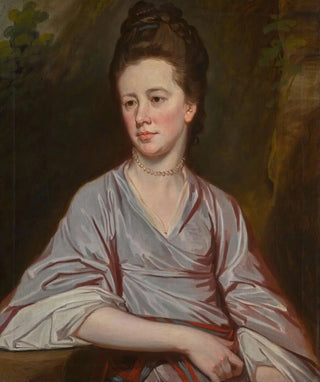Art print | Portrait of Miss Joan Knatchbull - George Romney


View from behind

Frame (optional)
In the fascinating world of 18th-century English painting, the art print "Portrait of Miss Joan Knatchbull" by George Romney stands out for its elegance and emotional depth. This piece, which captures the beauty and personality of a young woman from high society, demonstrates the artist's skill in immortalizing his models with remarkable finesse. Viewing this work, the viewer is immediately transported to a world where fashion, social status, and art blend harmoniously. The art print of "Portrait of Miss Joan Knatchbull" thus allows for a new perspective on this masterpiece, while celebrating the artistic legacy of its creator.
Style and uniqueness of the work
George Romney's style is often characterized by a delicate and refined approach, which is fully expressed in the portrait of Miss Knatchbull. The features of her face, finely detailed, are highlighted by light effects that give her expression an almost lifelike dimension. The color palette chosen by the artist, oscillating between soft tones and more vivid shades, creates a harmonious contrast that draws the eye. This painting does not merely depict a figure; it tells a story, that of a woman who is both strong and vulnerable, set within the context of a rapidly changing era. The composition, balanced and carefully thought out, reinforces the idea that every element of the work is significant, contributing to the overall visual narrative.
The artist and his influence
George Romney, born in Kendal in 1734, is one of the most renowned portraitists of his time. His artistic journey, marked by diverse influences ranging from Italian masters to contemporary artists, allowed him to develop a unique style that combines classicism and modernity. Romney was able to capture the spirit of his era, creating portraits of influential personalities and members of the nobility, while infusing his works with a sensitivity that transcends mere realism. His impact on British art is undeniable, and his legacy endures through generations, inspiring many contemporary artists to explore themes of beauty, identity, and society.

Matte finish

View from behind

Frame (optional)
In the fascinating world of 18th-century English painting, the art print "Portrait of Miss Joan Knatchbull" by George Romney stands out for its elegance and emotional depth. This piece, which captures the beauty and personality of a young woman from high society, demonstrates the artist's skill in immortalizing his models with remarkable finesse. Viewing this work, the viewer is immediately transported to a world where fashion, social status, and art blend harmoniously. The art print of "Portrait of Miss Joan Knatchbull" thus allows for a new perspective on this masterpiece, while celebrating the artistic legacy of its creator.
Style and uniqueness of the work
George Romney's style is often characterized by a delicate and refined approach, which is fully expressed in the portrait of Miss Knatchbull. The features of her face, finely detailed, are highlighted by light effects that give her expression an almost lifelike dimension. The color palette chosen by the artist, oscillating between soft tones and more vivid shades, creates a harmonious contrast that draws the eye. This painting does not merely depict a figure; it tells a story, that of a woman who is both strong and vulnerable, set within the context of a rapidly changing era. The composition, balanced and carefully thought out, reinforces the idea that every element of the work is significant, contributing to the overall visual narrative.
The artist and his influence
George Romney, born in Kendal in 1734, is one of the most renowned portraitists of his time. His artistic journey, marked by diverse influences ranging from Italian masters to contemporary artists, allowed him to develop a unique style that combines classicism and modernity. Romney was able to capture the spirit of his era, creating portraits of influential personalities and members of the nobility, while infusing his works with a sensitivity that transcends mere realism. His impact on British art is undeniable, and his legacy endures through generations, inspiring many contemporary artists to explore themes of beauty, identity, and society.






